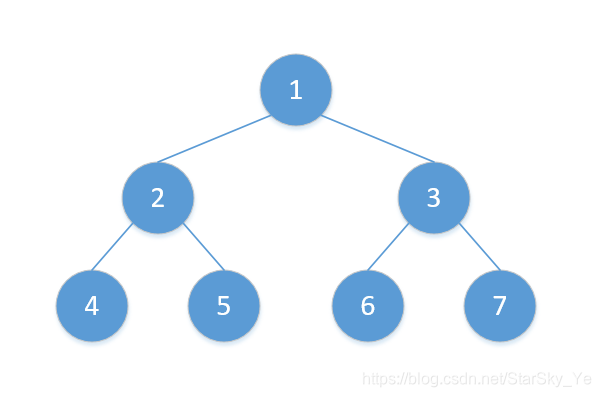文章目录
前言
本文主要记录二叉树的遍历方法,文章的主要知识点来源为:
https://leetcode-cn.com/problems/binary-tree-preorder-traversal/solution/leetcodesuan-fa-xiu-lian-dong-hua-yan-shi-xbian-2/
对于二叉树的遍历主要有三种形式,前序遍历、中序遍历、后序遍历;
所谓前序遍历,是指从根节点开始,对每一个节点,都采用先遍历该节点,再遍历其左子节点,最后遍历其右子节点的方式;
所谓中序遍历,是指从根节点开始,对每一个节点,都采用先遍历其左子节点,再遍历该节点,最后遍历其右子节点的方式;
所谓后序遍历,是指从根节点开始,对每一个节点,都采用先遍历其左子节点,再遍历其右子节点,最后遍历该节点的该当;
以一个二叉树图来说明一下。

对于上前所示的二叉树,其三种遍历方式的结果为:
前序遍历:1 2 4 5 3 6 7
中序遍历:4 2 5 1 6 3 7
后充遍历:4 5 2 6 7 3 1
下述中所用到的TreeNode数据结构如下所示:
class TreeNode:
def __init__(self, value, left=None, right=None) -> None:
self.m_value = value
self.m_left = left
self.m_right = right
def setLeftChild(self, left):
self.m_left = left
def setRightChild(self, right):
self.m_right = right
一、用递归法实现遍历
1.1 前序遍历
result = list()
def preOrderRecur(root: TreeNode):
# 若为空则返回
if not root:
return
# 先记录当前节点的值
result.append(root.m_value)
# 再递归记录其左子树的各个值
preOrderRecur(root.m_left)
# 最后递归记录其右子树的各个值
preOrderRecur(root.m_right)
1.2 中序遍历
result = list()
def inOrderRecur(root: TreeNode):
if not root:
return
# 先递归遍历其左子树的各个值
inOrderRecur(root.m_left)
# 再记录当前值
result.append(root.m_value)
# 最后递归遍历其右子树的各个值
inOrderRecur(root.m_right)
1.3 后序遍历
result = list()
def postOrderRecur(root: TreeNode):
if not root:
return
# 先递归遍历其左子树的各个值
postOrderRecur(root.m_left)
# 再递归遍历其右子树的各个值
postOrderRecur(root.m_right)
# 最后记录当前节点值
result.append(root.m_value)
二、用迭代法实现遍历
本质上是在模拟递归,因为在递归的过程中使用了系统栈,所以在迭代的解法中常用数据结构stack来模拟系统栈,在具体的python实现中,本文用list列表,且仅对最后一个元素作添加和删除操作来模拟栈,同时要注意的是栈是先进后出的数据结构。
2.1 前序遍历
基本的步骤是:
1 每访问到一个节点时,记录该节点的值;
2 之后按前序遍历的定义是要先记录左子树的值,再记录右子树的值,而栈是先进后出的结构特点,所以应该让其右子节点先入栈,再入左子节点。
result = list()
def preOrderIteration(root: TreeNode):
if not root:
return
nodeStack = list()
# 当前节点先入栈
nodeStack.append(root)
while len(nodeStack):
# 从栈中取出一个节点,表示的是当前遍历到该节点了
node = nodeStack.pop()
result.append(node.m_value)
if node.m_right:
nodeStack.append(node.m_right)
if node.m_left:
nodeStack.append(node.m_left)
2.2 中序遍历
基本步骤是:
1 创建一个Stack,以便于按 左 中 右的顺序输出节点。
2 尽可能的将这个节点的左子树压入Stack,此时栈顶的元素是最左侧的元素,其目的是找到一个最小单位的子树(也就是最左侧的一个节点),并且在寻找的过程中不断记录来源,这样才能逐步返回上层。在返回上层的时候,就意味着已经处理完毕左子树了。
3 当处理完最小单位的子树时,返回到上层处理了中间节点,记录下当前值。
4 判断如果有右节点,其也要对其进行一次中序遍历
result = list()
def inOrderIteration(root: TreeNode):
if not root:
return
currentNode = root
nodeStack = list()
while len(nodeStack) or currentNode:
while currentNode:
nodeStack.append(currentNode)
currentNode = currentNode.m_left
node = nodeStack.pop()
result.append(node.m_value)
if node.m_right:
currentNode = node.m_right
2.3 后序遍历
2.3.1 后序解法一
1 前序遍历的过程是 中 左 右,而后序遍历的过程是 左 右 中。
2 修改前序遍历的实现过程为,中 右 左;即在压栈时,优先压入左子树,再压入右子树;
3 将步骤2得到的结果,倒序输出,就是后序遍历所期望的 左 右 中的结果。
result = list()
def postOrderIteration(root: TreeNode):
if not root:
return
tmpResult = list()
nodeStack = list()
nodeStack.append(root)
while len(nodeStack):
node = nodeStack.pop()
tmpResult.append(node.m_value)
if node.m_left:
nodeStack.append(node.m_left)
if node.m_right:
nodeStack.append(node.m_right)
tmpResult.reverse()
result.extend(tmpResult)
2.3.2 后序解法二
基本步骤为:
1 用一个preNode,标记当前退出的节点是什么。
2 后序遍历的过程中,在遍历完左子树或右子树时,preNode都会回到其根结点。此时不应该再对该根结点的子节点做入栈操作,应该退回更上一层。
result = list()
def postOrderIteration2(root: TreeNode):
if not root:
return
preNode = root
nodeStack = list()
nodeStack.append(root)
while len(nodeStack):
# 注意,这里只是取栈顶元素,并没有出栈操作
node = nodeStack[-1]
if node.m_left and node.m_left != preNode and node.m_right != preNode:
# 左子节点存在,且当前节点不是从其左子树或者右子树回退回来的根节点,
# 此时可以入栈左子节点,以便于继续往左子树深入判断添加节点。
nodeStack.append(node.m_left)
elif node.m_right and node.m_right != preNode:
# 右子节点存在,且当前节点不是从其右子树回退回来的,意味着,
# 此时是遍历完了左子树后回退到根节点的,若此时有右子树的根节点,
# 需要继续入栈该节点,以遍历右子树。
nodeStack.append(node.m_right)
else:
# 走到这里,要么是已经访问到叶子节点了(即node.m_left和node.m_right都是None的结点,
# 或者是遍历完左右子树后,回退到其根结点了,此时需要记录该节点的值,
# 并更新preNode,记录当前处理的节点)
preNode = nodeStack.pop()
result.append(preNode.m_value)
三、测试验证
对代码作个测试验证。
def initTree():
root = TreeNode(1)
root_l = TreeNode(2)
root_r = TreeNode(3)
root_l_1 = TreeNode(4)
root_l_2 = TreeNode(5)
root_r_1 = TreeNode(6)
root_r_2 = TreeNode(7)
root_l.setLeftChild(root_l_1)
root_l.setRightChild(root_l_2)
root_r.setLeftChild(root_r_1)
root_r.setRightChild(root_r_2)
root.setLeftChild(root_l)
root.setRightChild(root_r)
result = list()
if __name__ == "__main__":
tree = initTree()
preOrderRecur(tree)
print("preOrderRecur", result)
result.clear()
inOrderRecur(tree)
print("inOrderRecur", result)
result.clear()
postOrderRecur(tree)
print("postOrderRecur", result)
result.clear()
preOrderIteration(tree)
print("preOrderIteration", result)
result.clear()
inOrderIteration(tree)
print("inOrderIteration", result)
result.clear()
postOrderIteration(tree)
print("postOrderIteration", result)
result.clear()
postOrderIteration2(tree)
print("postOrderIteration2", result)
最终的输出结果为:
preOrderRecur [1, 2, 4, 5, 3, 6, 7]
inOrderRecur [4, 2, 5, 1, 6, 3, 7]
postOrderRecur [4, 5, 2, 6, 7, 3, 1]
preOrderIteration [1, 2, 4, 5, 3, 6, 7]
inOrderIteration [4, 2, 5, 1, 6, 3, 7]
postOrderIteration [4, 5, 2, 6, 7, 3, 1]
postOrderIteration2 [4, 5, 2, 6, 7, 3, 1]